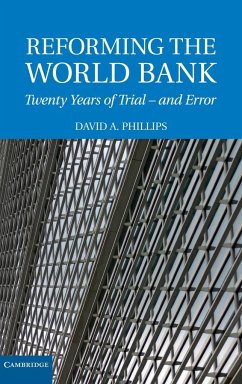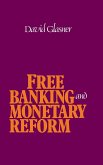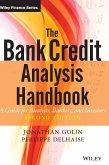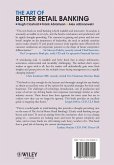- Gebundenes Buch
- Merkliste
- Auf die Merkliste
- Bewerten Bewerten
- Teilen
- Produkt teilen
- Produkterinnerung
- Produkterinnerung
This book explains why the World Bank has not achieved substantive efficiency or effectiveness in delivering economic assistance.
Andere Kunden interessierten sich auch für
![Free Banking and Monetary Reform Free Banking and Monetary Reform]() David GlasnerFree Banking and Monetary Reform65,99 €
David GlasnerFree Banking and Monetary Reform65,99 €![Central Bank Governance and Oversight Reform Central Bank Governance and Oversight Reform]() Central Bank Governance and Oversight Reform12,99 €
Central Bank Governance and Oversight Reform12,99 €![The Changing Face of Central Banking The Changing Face of Central Banking]() Pierre L. SiklosThe Changing Face of Central Banking80,99 €
Pierre L. SiklosThe Changing Face of Central Banking80,99 €![International Financial Market International Financial Market]() Anthony D. SmithInternational Financial Market92,99 €
Anthony D. SmithInternational Financial Market92,99 €![The Bank Credit Analysis Handb The Bank Credit Analysis Handb]() Jonathan GolinThe Bank Credit Analysis Handb226,99 €
Jonathan GolinThe Bank Credit Analysis Handb226,99 €![Megabank Consolidations in the United States Megabank Consolidations in the United States]() Ashford MaharajMegabank Consolidations in the United States23,99 €
Ashford MaharajMegabank Consolidations in the United States23,99 €![Art of Better Retail Banking Art of Better Retail Banking]() Hugh CroxfordArt of Better Retail Banking99,99 €
Hugh CroxfordArt of Better Retail Banking99,99 €-
-
-
This book explains why the World Bank has not achieved substantive efficiency or effectiveness in delivering economic assistance.
Produktdetails
- Produktdetails
- Verlag: Cambridge University Press
- Seitenzahl: 342
- Erscheinungstermin: 19. Mai 2011
- Englisch
- Abmessung: 235mm x 157mm x 25mm
- Gewicht: 707g
- ISBN-13: 9780521883054
- ISBN-10: 0521883059
- Artikelnr.: 26033280
- Herstellerkennzeichnung
- Libri GmbH
- Europaallee 1
- 36244 Bad Hersfeld
- gpsr@libri.de
- Verlag: Cambridge University Press
- Seitenzahl: 342
- Erscheinungstermin: 19. Mai 2011
- Englisch
- Abmessung: 235mm x 157mm x 25mm
- Gewicht: 707g
- ISBN-13: 9780521883054
- ISBN-10: 0521883059
- Artikelnr.: 26033280
- Herstellerkennzeichnung
- Libri GmbH
- Europaallee 1
- 36244 Bad Hersfeld
- gpsr@libri.de
David A. Phillips has spent many years in developing countries, especially in Africa. He is an economist who, after starting his career in multinational companies, turned his attention to the field of development, spending 14 years at the World Bank Group and in recent years working as director of a private consulting firm based in the UK and United States. Dr Phillips held a lectureship at the University of Bradford Development Centre in the UK and was an official at the Commonwealth Secretariat in London. He has also lived and worked on an extended basis in Tanzania, Nepal and Belarus. Dr Phillips has published journal papers on small business development and cost-benefit analysis.
Part I. Origins and Evolution: 1. What does the World Bank do and how does it do it?
2. The emerging critique
Part II. The Search for Effectiveness: 3. Fifty years of bank reforms
4. The 1990s - reengineering the organization
5. Changing culture and changing people
6. Reforming the bank's assistance product
7. Changing the quality of development assistance
8. Financing the reorganization
9. Why did the reforms fail?
Part III. Towards Real Reform: The Governance Agenda: 10. The governors and the directors
11. The leadership
12. Looking back and looking forward: what is to be done?
2. The emerging critique
Part II. The Search for Effectiveness: 3. Fifty years of bank reforms
4. The 1990s - reengineering the organization
5. Changing culture and changing people
6. Reforming the bank's assistance product
7. Changing the quality of development assistance
8. Financing the reorganization
9. Why did the reforms fail?
Part III. Towards Real Reform: The Governance Agenda: 10. The governors and the directors
11. The leadership
12. Looking back and looking forward: what is to be done?
Part I. Origins and Evolution: 1. What does the World Bank do and how does it do it?; 2. The emerging critique; Part II. The Search for Effectiveness: 3. Fifty years of bank reforms; 4. The 1990s - reengineering the organization; 5. Changing culture and changing people; 6. Reforming the bank's assistance product; 7. Changing the quality of development assistance; 8. Financing the reorganization; 9. Why did the reforms fail?; Part III. Towards Real Reform: The Governance Agenda: 10. The governors and the directors; 11. The leadership; 12. Looking back and looking forward: what is to be done?
Part I. Origins and Evolution: 1. What does the World Bank do and how does it do it?
2. The emerging critique
Part II. The Search for Effectiveness: 3. Fifty years of bank reforms
4. The 1990s - reengineering the organization
5. Changing culture and changing people
6. Reforming the bank's assistance product
7. Changing the quality of development assistance
8. Financing the reorganization
9. Why did the reforms fail?
Part III. Towards Real Reform: The Governance Agenda: 10. The governors and the directors
11. The leadership
12. Looking back and looking forward: what is to be done?
2. The emerging critique
Part II. The Search for Effectiveness: 3. Fifty years of bank reforms
4. The 1990s - reengineering the organization
5. Changing culture and changing people
6. Reforming the bank's assistance product
7. Changing the quality of development assistance
8. Financing the reorganization
9. Why did the reforms fail?
Part III. Towards Real Reform: The Governance Agenda: 10. The governors and the directors
11. The leadership
12. Looking back and looking forward: what is to be done?
Part I. Origins and Evolution: 1. What does the World Bank do and how does it do it?; 2. The emerging critique; Part II. The Search for Effectiveness: 3. Fifty years of bank reforms; 4. The 1990s - reengineering the organization; 5. Changing culture and changing people; 6. Reforming the bank's assistance product; 7. Changing the quality of development assistance; 8. Financing the reorganization; 9. Why did the reforms fail?; Part III. Towards Real Reform: The Governance Agenda: 10. The governors and the directors; 11. The leadership; 12. Looking back and looking forward: what is to be done?








